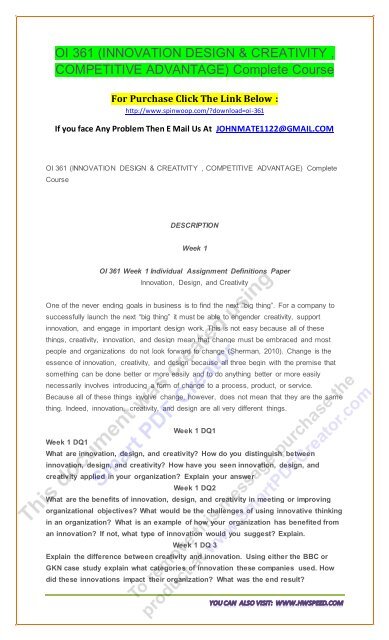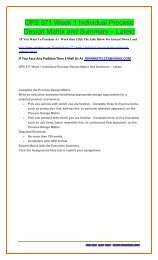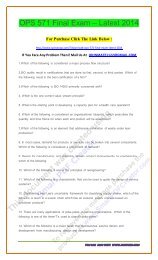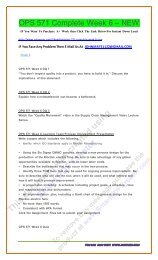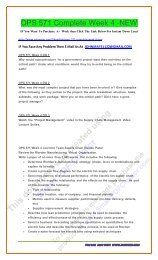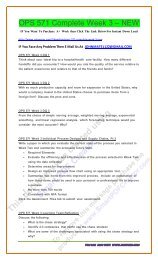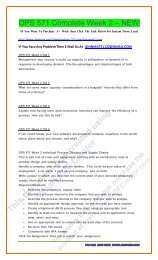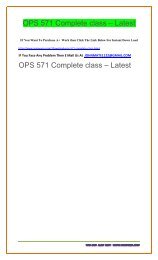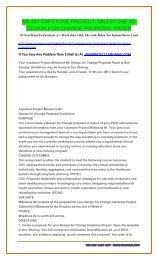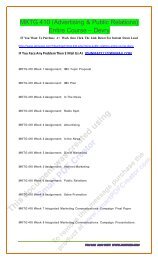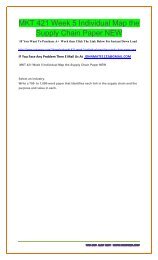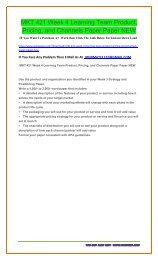OI 361 (INNOVATION DESIGN & CREATIVITY , COMPETITIVE ADVANTAGE) Complete Course
You also want an ePaper? Increase the reach of your titles
YUMPU automatically turns print PDFs into web optimized ePapers that Google loves.
<strong>OI</strong> <strong>361</strong> (<strong>INNOVATION</strong> <strong>DESIGN</strong> & <strong>CREATIVITY</strong> ,<br />
<strong>COMPETITIVE</strong> <strong>ADVANTAGE</strong>) <strong>Complete</strong> <strong>Course</strong><br />
For Purchase Click The Link Below :<br />
http://www.spinwoop.com/?download=oi-<strong>361</strong><br />
If you face Any Problem Then E Mail Us At JOHNMATE1122@GMAIL.COM<br />
<strong>OI</strong> <strong>361</strong> (<strong>INNOVATION</strong> <strong>DESIGN</strong> & <strong>CREATIVITY</strong> , <strong>COMPETITIVE</strong> <strong>ADVANTAGE</strong>) <strong>Complete</strong><br />
<strong>Course</strong><br />
DESCRIPTION<br />
Week 1<br />
<strong>OI</strong> <strong>361</strong> Week 1 Individual Assignment Definitions Paper<br />
Innovation, Design, and Creativity<br />
One of the never ending goals in business is to find the next ―big thing‖. For a company to<br />
successfully launch the next ―big thing‖ it must be able to engender creativity, support<br />
innovation, and engage in important design work. This is not easy because all of these<br />
things, creativity, innovation, and design mean that change must be embraced and most<br />
people and organizations do not look forward to change (Sherman, 2010). Change is the<br />
essence of innovation, creativity, and design because all three begin with the premise that<br />
something can be done better or more easily and to do anything better or more easily<br />
necessarily involves introducing a form of change to a process, product, or service.<br />
Because all of these things involve change, however, does not mean that they are the same<br />
thing. Indeed, innovation, creativity, and design are all very different things.<br />
Week 1 DQ1<br />
Week 1 DQ1<br />
What are innovation, design, and creativity? How do you distinguish between<br />
innovation, design, and creativity? How have you seen innovation, design, and<br />
creativity applied in your organization? Explain your answer<br />
Week 1 DQ2<br />
What are the benefits of innovation, design, and creativity in meeting or improving<br />
organizational objectives? What would be the challenges of using innovative thinking<br />
in an organization? What is an example of how your organization has benefited from<br />
an innovation? If not, what type of innovation would you suggest? Explain.<br />
Week 1 DQ 3<br />
Explain the difference between creativity and innovation. Using either the BBC or<br />
GKN case study explain what categories of innovation these companies used. How<br />
did these innovations impact their organization? What was the end result?
Week 1 DQ4<br />
This week’s reading reviewed three techniques to enhance or encourage people to<br />
think in new ways. What are these three approaches? Give me a real life example<br />
where you have seen one of these approaches being used. What was the impact?<br />
WEEK 2<br />
<strong>OI</strong> <strong>361</strong> Week 2 Individual Assignment Case Study “Creative Thinkers” Paper<br />
Not a single day goes by when one cannot find a television commercial, often late at night,<br />
hawking some product or another—usually offering to include extra ―free‖ items as part of<br />
the order with a tagline of something like ―But Wait! There’s more!‖<br />
Samuel Popiel made his first sales pitch at Macy’s inNew York. In 1945, he and his brotherr<br />
Raymond formed a company named Popiel Brothers, which manufactured small kitchen<br />
gadgets.<br />
In 1956, Samuel’s son Ron was selected by The Grant Company to appear in four-minute<br />
commercials for ―The Chop-o-matic,‖ a manually-operated food chopper that was offered as<br />
an affordable option to a blender. Ron continued to work for Woolworth during the week,<br />
and he also hawkied Popiel products atChicago’s Maxwell Street Market on the<br />
weekends. Maxwell Street Market is where he really began to develop his showmanship.<br />
<strong>OI</strong> <strong>361</strong> Week 2 Individual Assignment Case Study Creative Thinkers<br />
Mark Zuckerberg may not be a household name to most people. In fact your<br />
average person may not have any idea who he is or what he has done to shape the way<br />
people communicate on the internet. Mark Zuckerberg is one of the youngest faces of<br />
American success; while he may not be the youngest, he is the youngest creator with the<br />
highest net worth that has shocked America today. Zuckerberg got his inspiration as a<br />
college student when he and some friends created a website that would enable them to<br />
keep in touch with one another after graduation. Mark Zuckerberg, is the creator and<br />
founder of Facebook; an internet social page that connects millions of people to one<br />
another through the internet, whether it’s reuniting long lost friends and relatives or keeping<br />
in touch with current friends and neighbors whether right next door or around the world.<br />
Facebook is not only a growing trend in the United States, but is booming in<br />
countries across the globe. Millions of people log onto the server each day. Reports<br />
indicate that Facebook gets more hits a day than any other website. Facebook is a textbook<br />
example of an innovative business. The organization is under Mark’s direction with no<br />
organization ladder or consultants needed when changes are made, which means that<br />
Zuckerberg is flexible and can make changes to the organization when he sees fit to do so.<br />
It is planned in upcoming months the website will launch a new location called Facebook<br />
Places, and will allow users to tell others about themselves and their businesses. Other<br />
research indicates that Zuckerberg will launch face to face video conferencing; this is just<br />
another way that the founder and CEO will be reinventing the free website with creative new<br />
ideas for the benefit of all users.<br />
<strong>OI</strong> <strong>361</strong> Week 2 Individual Assignment Case Study Creative Thinkers Presentation
<strong>OI</strong> <strong>361</strong> Week 2 Learning Team Assignment Benefits and Drivers Proposal<br />
Benefits and Drivers Proposal<br />
Innovation, design, and creativity are about finding ways to improve products and services<br />
within an organization. The goal is to encourage and increase innovation to maximize on<br />
profits and produce organizational success. Organizational goals and objectives are aimed<br />
at these same positive outcomes. Through the use of innovation, an organization can create<br />
more usable, demanded, and updated products, and services that support the company<br />
goals. University of Phoenix is an accredited university, provides staff with real-world<br />
experience, and offers both on campus and online classes (UOPX, 2006-2011). University<br />
of Phoenix is rather innovative in offering educational opportunities through the use of the<br />
computer. These online course offerings alone prove how understanding the company is<br />
about student’s personal lives and responsibilities. Improvement can always be made and<br />
an objective assessment of internal and external successes and failures are critical to<br />
remaining one of the most innovative organizations in the world.<br />
Week 2 Summary<br />
1. What are the most important concepts or processes you have learned this week? One<br />
thing I have learned from this week is the difference between an operational company and<br />
an innovative organization. Although, I believe in having creative thinkers as employees. I<br />
believe it is just as important to have innovative managers. Also, if innovation is a direction<br />
the organization wants to go they must understand their customers as well as their own<br />
goals.<br />
Week 2 DQ 1<br />
What is disruptive innovation? What is difference between incremental change and<br />
disruptive change? How would a disruptive innovation impact your organization?<br />
Week 2 DQ 2<br />
What are the different types of organizations? What is an example of a significant<br />
innovative organization within the service sector (Google, Yahoo!, eBay ® , etc.)? Why?<br />
What organizational type is representative of your organization, and what are the<br />
opportunities for innovation within that type of organization?<br />
Week 2 DQ 3<br />
How would you define strategy, process, product, and services? How are strategy,<br />
process, product, and services related? What could be the impact of innovation,<br />
design, and creativity on strategy?<br />
WEEK 3<br />
<strong>OI</strong> <strong>361</strong> Week 3 Individual Assignment Organizational Impact Paper<br />
Innovation in Different Industries<br />
An innovation is something that causes a business or person to alter the way something<br />
looks, is used, or operates. Innovation is ―the introduction of something new‖ and may be an<br />
idea, method, or device (Innovation, 2010). Innovation has been a constant in business, as<br />
in human life, since the world first came into existence. If one views innovation as nothing<br />
more than evolution, which is an adaptation or change to changes in conditions or in an<br />
effort to improve one’s ease, then one understands that it is a natural development in the
life of man or an organization. Business innovation can be traced to the development of the<br />
first trade businesses to the Industrial Revolution to the modern day’s many different ways<br />
of conducting business and the many different businesses that exist in the present day.<br />
<strong>OI</strong> <strong>361</strong> Week 3 Learning Team Assignment Strategy, Process, Product, and Services<br />
Paper<br />
Strategy, Process, Product, and Services Paper<br />
The deployment of innovation and creativity can have many positive influences on company<br />
outcomes. University of Phoenix (UOPX) must consistently integrate innovation and<br />
creativity into every facet of their business to remain competitive, produce high education<br />
levels for its students, and accommodate students who retain knowledge in different<br />
manners. Through this paper, team B will evaluate the impact of innovation and creativity<br />
the UOPX’s organizational strategy, processes, products, and services in an effort to bring<br />
awareness to the correlation of innovation and creativity and positive company outcomes.<br />
Impact of Innovation and Creativity on Organizational<br />
Strategy,<br />
Processes, Products and Services<br />
The history of the ―University of Phoenix‖ provides an outline illustrating how innovation and<br />
creativity impact organizational strategies, processes, products and services. Innovations in<br />
education-driven, the UOPX pioneered systems designed to provide an environment<br />
beneficial to the learning process. Creativity and innovation are the foundation of access to<br />
student schedules, compatible to the student’s schedule. Enhancement of learning<br />
experience is strategy of small class sizes, an average of 15, enabling positive environment,<br />
caused by low student to instructor ratios. The learning experience is augmented from<br />
learning from instruction by advanced degree working professionals. Innovation’s impact is<br />
evidential by the introduction of a collaborative team learning environment resulting in<br />
accreditation from Higher Learning Commission. The most significant affirmation of impact<br />
by creativity and innovation is the dedication to support representatives focusing on<br />
enrollment, academics, and financial concerns.<br />
Week 3 Summary<br />
What are the most important concepts or processes you have learned this week?<br />
The most important concepts learned this week was mindset and mental models. the<br />
concepts of creative intelligence and the various ways we used the concepts were learned.<br />
having a creative intelligence show we are open for change and will accept things for what<br />
they can be instead of what is showed. Opening your mind to change and accepting the<br />
mental mindsets of seeing is not just believing but just because you cannot see something<br />
does not mean you cannot believe it.<br />
Week 3 DQ 1<br />
What is a mental model/mindset? What forces influence a mental model/mindset, and<br />
what forces cause the evolution of that mental model/mindset? How has your mental<br />
model/mindset limited your decision-making?
Week 3 DQ 2<br />
What is creative intelligence? What are the differences between the four types of<br />
creative intelligence? What is your creative potential profile? Explain.<br />
Week 3 DQ 3<br />
What are the four steps that change your mental model/mindset? Provide examples.<br />
What are some of the possible inhibitors of changing your mental models/mindsets?<br />
What is an example of a mental model/mindset of yours that you would like to<br />
change? What are the inhibitors associated with making that change?<br />
WEEK 4<br />
<strong>OI</strong> <strong>361</strong> Week 4 Individual Assignment Mental Process Paper<br />
Creative Intelligence, Five Forces, and Mental Models/Mindsets<br />
A number of issues exist that have an influence on organizational decisionmaking.<br />
Aside from the written policies, mission, vision, and budget of an organization,<br />
other influences can create an impact. These influences include the creative intelligence<br />
preferences of the decision-makers and their teams, Porter’s five forces and their influence<br />
on mental models and mindsets, as well as mental models and mindsets taken on their<br />
own. Mental models and mindsets can limit the decision-making process if they are<br />
conducted in a vacuum. In addition, each individual possesses mental models and<br />
mindsets that guide them in their decision-making processes in the workplace. To that end,<br />
this paper is an examination of the four styles of creative intelligence and their influence on<br />
organizational decision making, the five forces and their influences on mental models and<br />
mindsets, the way mental models and mindsets limit decision-making processes, and the<br />
manner in which my own mental models and mindsets influence my decision-making within<br />
the Marine Corps Recruiting Command.<br />
<strong>OI</strong> <strong>361</strong> Week 4 Learning Team Assignment Mental Models and Mindsets Paper<br />
Mental Models and Mindsets Paper<br />
Organizational growth relies on the mental models and mindsets of every stakeholder in the<br />
firm. Mental models represent the way people look at the world and how he or she reacts to<br />
new ideas, processes, and innovations – ―and if someone comes along and questions us as<br />
to why we do things the way we do, it can help us to realize the mental models we have,<br />
and hence enable us to change them‖ (Von Stamm, 2003, p. 161). In this paper the subject<br />
to analyze is the four steps to change our mental models and mindsets – understand mental<br />
models, test new approaches, overcome inhibitors to change, and implement change to<br />
thinking patterns.<br />
Week 4 Summary<br />
1. What are the most important concepts or processes you have learned this week?<br />
The most important concepts or processes learned this week for the innovation process and<br />
the environment we have to improve on it. Using collaboration, brainstorming or just<br />
teamwork we can come up with plans to make things bigger and better. How we accept
these ideas and put them into the design, creativity and decision making process is what is<br />
needed to accept the change of we all have creativity and innovation to make the<br />
organization better. Using the mental/model and mind sets to keep the decision going in the<br />
organization is where we want to keep an open mind and work with the employee of all<br />
levels to know that their ideas or important and we want to hear them.<br />
Week 4 DQ 1<br />
What are some of the idea generating tools and techniques for innovation, design,<br />
and creativity? How do you create an innovative environment? How have you used<br />
one of the idea generating tools and techniques in your own decision making?<br />
Explain.<br />
Week 4 DQ 2<br />
What are the four steps in the closing the loop process? Why is the closing the loop<br />
process important in the innovative process? How would you utilize the evaluation of<br />
the results for the process of continuous improvement?<br />
Abstract<br />
WEEK 5<br />
<strong>OI</strong> <strong>361</strong> Week 5 Individual Assignment Organizational Transformation Q&A<br />
This paper will allow readers to better understand the roles of training, incentives,<br />
and education given in innovation inside the enrollment department at the Trinity Valley<br />
Community College (TVCC). An understanding of the role of leadership in creating<br />
managing, and sustaining innovation is spoken to, and the ethical implications and rewards.<br />
An article spoke about the importance of customer service quality, and strategies<br />
needed within an environment that has high contact. The department of enrollment at TVCC<br />
is a high contact environment that interacts with the public on a daily basis. The enrollment<br />
environment crosses with continuous training development, innovation, and education<br />
because of the competition and the constant changing both in the technology world and the<br />
education environment.<br />
<strong>OI</strong> <strong>361</strong> Week 5 Learning Team Assignment Innovation Process Paper<br />
Innovation Process<br />
Competitive markets are inevitable in any sector and the originality to create products that<br />
will attract the great majority of the market share is what will determine the success of a<br />
company. University of Phoenix is a synonym of innovation, in addition, the university is a<br />
trendsetter; others in the industry had followed. University of Phoenix uses every aspect of<br />
innovation to its advantage and achieved its goals. Moreover, the institution creates<br />
strategies based on the student experience and empowering its employees to generate<br />
ideas and services that will create an exceptional student experience.<br />
<strong>OI</strong> <strong>361</strong> Week 5 Learning Team Assignment Innovation Process Paper and<br />
Presentation<br />
Week 5 Summary<br />
. What are the most important concepts or processes you have learned this week?
The most important concepts or processes learned this week were incentives for creating<br />
and keeping an innovative organization going and the ethics issues for rewarding people for<br />
their innovative minds. Reward programs are great for the benefit of moral and to start<br />
them and then to abruptly end them with notice can destroy the moral of the organization. I<br />
think it is ok to reward individuals for their best effort and their going beyond the call of<br />
duty to add more to the organization. Rewarding them and keeping them in your<br />
organization help with their choice of leaving and feeling not appreciated and going to the<br />
competition.<br />
Week 5 DQ 1<br />
Describe a major change in your organization in which you had to adjust to in which<br />
you disagreed in the change. How did you handle it?<br />
Week 5 DQ 2<br />
Explain a situation in which you had to analyze information from a focus group or<br />
brainstorming session and make a recommendation? Explain the thought process<br />
you went through. How did you handle pushback from those who submitted ideas<br />
that were rejected?


